Ralf and Florian, 1973. Back cover photo by Barbara Niemöller.
At that time, Kling Klang Studio was far from the technological hub it would become. “The studio was a big room in an old factory building with brick walls,” recalls [Wolfgang] Flür. “There were big home-made speakers, amplifiers and so on. Florian had his side, with his flutes and one of the very first ARP Odyssey synthesizers, while Ralf’s side had Hammond and Farfisa organs and a Minimoog synthesizer.”
Andy Gill, Mojo magazine, April 1997
Last week’s Autobahn post prompted a week of revisiting Kraftwerk’s three pre-Autobahn albums, all of which remain unreissued. The photo that fills out the back cover of the third album, Ralf & Florian (1973), has appeared here twice before so if you want an example of an obsession look no further. I only have a bootleg CD of this one, a package that doesn’t do much for the photograph so I went searching for a larger copy.
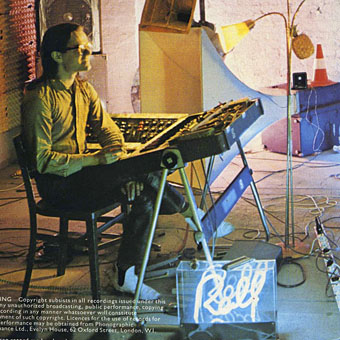
The attractions, if you have to list them, are multiple: Ralf & Florian is Kraftwerk’s most human album, and the cover photos reflect this. Trans-Europe Express originally had pictures of the group on its sleeve (now replaced by the TEE train) but they were airbrushed, idealised portraits; the showroom-dummy personas they adopt there would turn into robots on the album that followed. There’s an overt sense of camp about the Ralf & Florian cover shots that runs counter to the tenor of rock music in 1973. The charts in Britain might have been filled with glam acts but for all their flirtatious androgyny they were selling the same assertive macho sexuality as the big rock bands of the time. One of the things I enjoy about this cover photo is its refusal to follow that crowd: the neon name signs, the standard lamp from a 1950s’ living room, Florian’s semiquaver brooch; all are effete enough to give Deep Purple the vapours. (The first UK release of Ralf and Florian replaced the cover photo of the pair with a printed circuit.) The closest comparison in the same year would be the sleeve for Brian Eno’s Here Come The Warm Jets with its shelves of dead flowers and junk-shop discoveries. But this wasn’t so surprising for an ex-member of Roxy Music, and Eno’s album is still very much a rock production.
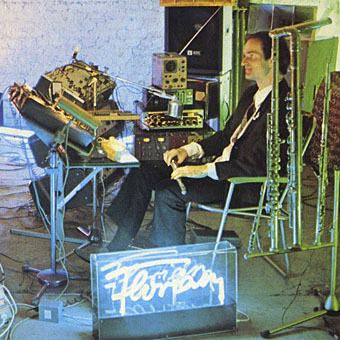
Then there’s the details: the egg-box soundproofing (Can used old mattresses to soundproof their studio); the enormous white speaker; the traffic cone that nods back to the sleeves of the first two albums and forward to the automotive theme of the next; Ralf’s white shoes (and is he wearing leather trousers?); Florian’s oscilloscope, his mysterious tone generators and that peculiar stringed instrument. This diverse range of gear somehow produced the music you’re listening to.
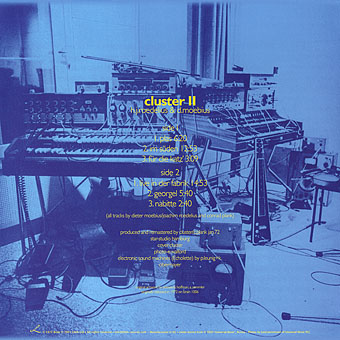
The display of equipment is always linked for me with a similar display a year before by another German duo, Cluster, in a photo that appeared originally inside the gatefold sleeve of their second album, Cluster II. (Cluster are also connected to Kraftwerk by guitarist Michael Rother, who worked with both bands, and producer Conny Plank.) There’s the same array of keyboards, tone generators, snaking wires, effects pedals and yet another peculiar stringed instrument. A photo inside the gatefold of their first album shows that they too had an oscilloscope. Cluster II, however, is much closer in sound to the first two Kraftwerk albums than the electronic melodies of Ralf & Florian. The early Cluster albums are abrasive enough to be precursors of Industrial music, and serve as further examples of my pet theory that many of the electronic German groups had to pass through a kind of noise barrier before developing a musical style of their own.
Cluster, 1971.
If this tech-fetishism seems rather quaint now it’s worth remembering the hostility such non-rock gear used to raise at the time. In the mid-70s the NME published The NME Book of Rock, an encyclopedic guide to rock music from the 1950s on. Kraftwerk were one of the few German bands allowed an entry, and the comments towards them and their audience were scathing. Many rock journalists loathed electronic music, and wouldn’t entertain the idea that this might be the music of the future. We know how that turned out, don’t we?
Previously on { feuilleton }
• Autobahnen
• Ralf and Florian
• Reworking Kraftwerk
• Autobahn animated
• Sleeve craft
• Who designed Vertigo #6360 620?
• Old music and old technology
• Aerodynamik by Kraftwerk

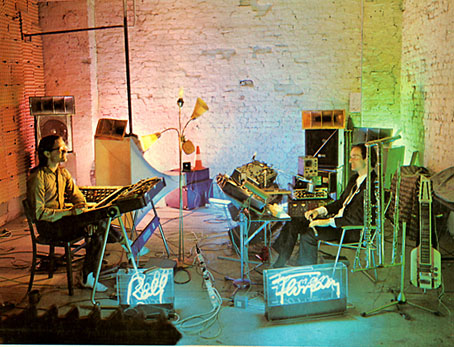
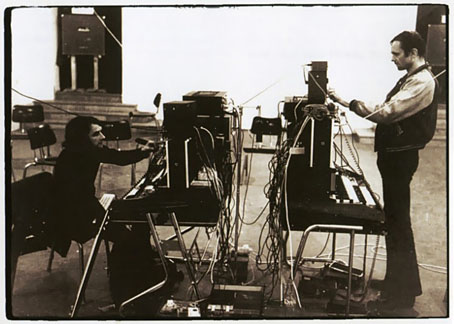
Hi John – It’s a fascinating picture if you’re a fan. A little snap-shot into a secret space at a special time. Looking at it and the Cluster picture, I get a serious twinge of retro-futuristic nostalgia. The piles of keyboards,wires and mysterious boxes seem to suggest endless sonic possibilites and new ground awaiting to be broken. The smiles between Ralf and Florian – “Well, where shall we go tonight?”. I’m sure it wasn’t as much fun wrestling with primitive, unreliable equipment as we romantically imagine it to be. But compare it with the picutures of the Kling Klang studio of the 1990s on “The Mix” album and even though there are exponentially more powerful sonic resources on show it looks….sterile.
You could pick out some other connections between Kraftwerk and Cluster at this time, aside from messy equipment and Michael Rother. “Ananas Symphonie” from “Ralf and Florian” seems to share the same blissed-out, oceanic ambience as “Ahoi!” from Harmonia’s slightly later first album.
It’s a real pity that Kraftwerk seem embarrassed by those first albums and haven’t to date bothered to reissue them. All three of them are never less than interesting and I think “Kraftwerk 1” in particular is a geniunely great album of early K-Rock, noise and proto-motorik. There’s talk from Ralf of a box-set release but well…if you’re a fan you always take talk of album activity with a mountain of salt.
P.S. Love the site, so many overlapping audio-visual interests. A visit to Feuilleton and a strong cup of tea is the best way to start the day for me.
Hi Graeme. Yes, there’s a few parallels to be found between Cluster and Kraftwerk. Cluster also made two noisy albums then changed direction and did their own faux-naive thing with Zuckerzeit. And the chugging rhythms of their mid-70s recordings are very similar to those on Ralf & Florian.
The situation with the early Kraftwerk albums is frustrating but it’s also rather admirable in a way; they’d make a lot of money if they reissued those records so it’s obviously an artistic decision. This is very rare in the music business; Stanley Kubrick famously refused to re-release his first film while he was alive, and there are many examples of authors being unwilling to see their early work republished. But I can’t think of another group of Kraftwerk’s stature who reject not one but three early works in this manner. Usually the only thing that prevents reissues is some kind of legal wrangle.
I don’t mind too much. At the moment I’m more eager to hear the reworked versions of their back catalogue that they’ve been touring everywhere. There are plenty of bootlegs doing the rounds but I’ve yet to hear anything in decent quality.